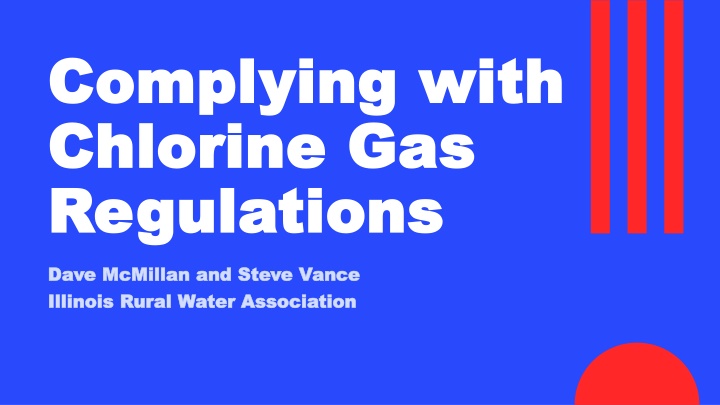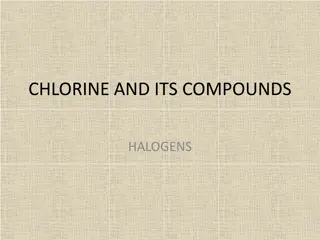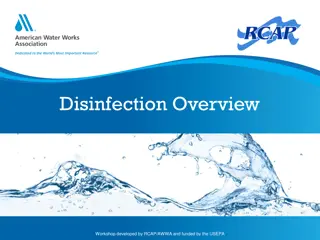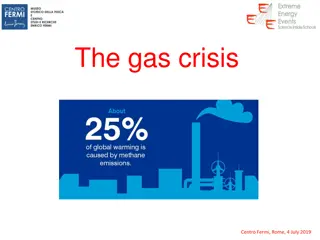Complying with Chlorine Gas Regulations
Explore the compliance and reporting requirements related to handling chlorine gas in water treatment facilities. Learn about the regulations set by organizations like IEMA, EPA, and OSHA, emphasizing safety measures, reporting thresholds, and emergency planning in response to hazardous substances. Gain insights on EPCRA and its significance in safeguarding community health and environmental protection.
Download Presentation

Please find below an Image/Link to download the presentation.
The content on the website is provided AS IS for your information and personal use only. It may not be sold, licensed, or shared on other websites without obtaining consent from the author.If you encounter any issues during the download, it is possible that the publisher has removed the file from their server.
You are allowed to download the files provided on this website for personal or commercial use, subject to the condition that they are used lawfully. All files are the property of their respective owners.
The content on the website is provided AS IS for your information and personal use only. It may not be sold, licensed, or shared on other websites without obtaining consent from the author.
E N D
Presentation Transcript
Complying with Complying with Chlorine Gas Chlorine Gas Regulations Regulations Dave McMillan and Steve Vance Dave McMillan and Steve Vance Illinois Rural Water Association Illinois Rural Water Association
What we have learned What we have learned in the last year in the last year Illinois Emergency Management Agency/Local Emergency Planning Committee Requirements Illinois Department of Labor / Occupational Safety and Health Administration Requirements U.S. EPA Requirements Illinois EPA Requirements 2
Discussion Discussion Outline Outline IL EPA IL EPA IEMA / IEMA / LAPC LAPC IDoL IDoL / OSHA / OSHA U.S. EPA U.S. EPA PERMIT FOR USE IN WATER TREATMENT WORKER SAFETY CONCERNS POTENTIAL RECEPTORS PUBLIC AWARENESS 2,500 pounds Quantity doesn t matter 1,500 pounds Quantity doesn t matter Reporting Requirements Safety procedures and employee training Risk Management Gas Scrubber 3
Compliance with IEMA/LAPC Compliance with IEMA/LAPC REPORTING REQUIREMENTS REPORTING REQUIREMENTS Community Right-To- Know (EPCRA) Where to report Compliance 4
EPCRA EPCRA 1986 Congress passed the Emergency Planning and Community Right-to-Know Act Response to Union Carbide releases in Bhopal, India (December 1984) and West Virginia (1985) Purpose Emergency Planning Emergency Release Notification Chemical Storage Reporting Chemical Release Reporting 5
EPCRA NOTIFICATION EPCRA NOTIFICATION REQUIREMENTS REQUIREMENTS Local Planning Requirement Triggered for water supplies Chlorine gas is considered an Extremely Hazardous Chlorine gas is considered an Extremely Hazardous Substance with a threshold planning quantity of 100 Substance with a threshold planning quantity of 100 pounds (Section 302) pounds (Section 302) Must notify Local Emergency Planning Committee Must notify Local Emergency Planning Committee (LEPC) (LEPC) Must notify State Emergency Response Commission Must notify State Emergency Response Commission (SERC) (SERC) REFERENCE: 40 CFR 370.10 (reporting thresholds), 40 electronic CFR 355 (electronic list of hazardous chemicals), U.S. EPA s List of Lists (list of hazardous chemicals) 6
EPCRA LEPC EPCRA LEPC Notification if storing Notification if storing over 100 pounds over 100 pounds Provide name of the water supply Emergency Response Coordinator (ROINC, designee, etc.) Provide Chlorine Safety Data Sheet (and any other chemicals that are relevant) Provide additional requested information Provide changes relevant to emergency planning 7
By March 1 every year By March 1 every year Supply Inventory Information to LEPC, the SERC and Local Fire Department Use State Specific Tier II Form https://iemaohs.illinois.gov/preparedness/se rc/serc-tier2.html Note: chlorine CAS 7782-50-5 8
March 1 Report Continued: March 1 Report Continued: Note the following excerpt from the url: New facilities should contact IEMA no later than 60 or 90 days, to request a new account for Hazconnect , depending on the chemicals involved. Existing & new facilities are required to submit a 311 (90 days) or 302 (60 days) Report on Hazconnect , in a timely manner. Please see the CHEMICAL INVENTORY REPORTING REQUIREMENTS After you have completed your 2023 ANNUAL Tier II submission, PRINT out hard copies, sign at the bottom of Page 1, and submit the report, as well as new or updated site plans and SDSs, to your LEPC and fire department (links in upper right corner of this webpage). DO NOT SUBMIT HARD COPIES TO IEMA-OHS. HARD COPIES ARE NOT ACCEPTED AND WILL BE SHREDDED. All facilities within the State of Illinois are required to submit Annual Reports beginning January 1st each year. IEMA-OHS reserves the right to provide Federal EPA notification of delinquent accounts, which fail to submit Annual Reports by March 1st each year. Inquiries should be made to Mr. David Martin, IEMA-OHS Hazardous Materials Unit Manager, at 217-558-0559 or ema.tier2mgr@illinois.gov. Click here for HazconnectTM Online Submission Program 9
EPCRA Emergency EPCRA Emergency Notification if release more Notification if release more than 10 pounds in 24 hours than 10 pounds in 24 hours Reportable Quantity under EPCRA and the Comprehensive Emergency Response, Compensation, and Liability Act (CERCLA) If release more than 10 pounds in 24 hours If release more than 10 pounds in 24 hours 10
Be prepared to provide Be prepared to provide details of release details of release immediately (WITHIN 15 immediately (WITHIN 15 MINUTES) MINUTES) The SERC at 1-800-782-7860 (within state) or (217) 782- 7860 The LEPC (for contact information see: https://iemaohs.illinois.gov/content/dam/soi/en/web/iemaoh s/preparedness/serc/documents/lepc- releasereportingcontactlist.pdf ) The National Response Center (NRC) at NRC 1-800-424- 8802 11
EPCRA Release EPCRA Release - - Immediate Information Information Chemical Name State chlorine gas is an extremely hazardous substance Estimate quantity lost Time of release and duration Where it went (air, land or water) Health risks and medical concerns (MSDS sheet information) Community precautions or actions taken (e.g., evacuation, shelter in place, etc.) Contact Person and phone number Immediate 12
EPCRA Report EPCRA Report - - Follow Follow- -up Information up Information Written report (WITHIN 30 DAYS): Update initial information Actions taken Known or anticipated chronic health risks Medical attention advice for those exposed 13
OSHA WORKER SAFETY OSHA WORKER SAFETY Illinois has an approved State Plan that covers state and local government workers only. General Provisions Apply to all Public Works Departments Water systems that store 1,500 pounds or more chlorine gas. Process Safety Management (PSM) Program The Division of Occupational Safety and Health (IL OSHA) is part of the Illinois Department of Labor (IDOL). IL OSHA has offices in Springfield, Chicago, and Marion. Illinois Department of Labor, Division of Occupational Safety and Health Lincoln Tower Plaza 524 South 2nd Street, Suite 400 Springfield, IL 62701 Tel: (217) 782-9386 For additional information: https://www.osha.gov/process-safety-management https://www.osha.gov/stateplans/#:~:text=Illinois,are%20covered%20by%20federal%20OSHA. https://www.osha.gov/laws-regs/regulations/standardnumber/ 14
All Public Works Departments All Public Works Departments Injury Illness Records Recordkeeping - Recordkeeping Forms | Occupational Safety and Health Administration (osha.gov) Occupational Noise Exposure Hearing Conservation Program Occupational Noise Exposure - Hearing Conservation Program | Occupational Safety and Health Administration (osha.gov) Exposure to Air Contaminants Sawing concrete / blacktop, list of hazardous chemicals (Safety Data Sheets) OSHA: Protecting Workers From Workplace Air Contaminants (stpub.com) 15
All Public Works Continued: All Public Works Continued: Hazard Communication Program including training program(s) Steps to an Effective Hazard Communication Program for Employers That Use Hazardous Chemicals (osha.gov) Confined Spaces all Confined Spaces and Permit Required Confined Spaces Confined Spaces - Overview | Occupational Safety and Health Administration (osha.gov) Respiratory Protection (if you require employee to wear a respirator https://www.osha.gov/respiratory-protection 16
All Public Works Continued: All Public Works Continued: Control of Hazardous Energy (Lockout/Tagout) Control of Hazardous Energy (Lockout/Tagout) - Overview | Occupational Safety and Health Administration (osha.gov) PPE Hazard Assessment Microsoft Word - PPE Assessment.doc (osha.gov) Work Zone Safety Manual on Uniform Traffic Control Devices Highway Work Zones and Signs, Signals, and Barricades - Overview | Occupational Safety and Health Administration (osha.gov) 17
Over 1,500 Pounds of Chlorine Over 1,500 Pounds of Chlorine Gas Gas Process Safety Plan and Program Process Safety Management for Storage Facilities (osha.gov) 18
Illinois OSHA On Illinois OSHA On- -Site Consultation Site Consultation Program Program Free and Confidential Safety and Health Advise Provides Recommendations to improve workplace safety and health 1-800-972-4216 IL On-Site Safety and Health Consultation Program - Consultation (illinois.gov) 19
Clean Air Act 112(r) Risk Clean Air Act 112(r) Risk Management Plans and Programs Management Plans and Programs Purpose of Rule: Prevent accidental releases Mitigate release consequences Inform the public and government Applies to water systems that store 2,500 pounds or more chlorine gas. Protects individuals, the general public, environment and infrastructure NOT THE SAME AS OSHA PSM For additional information: Risk Management Program (RMP) Rule | US EPA 20
PROGRAM LEVEL 3 PROGRAM LEVEL 3 Management System Hazard Assessment Prevention Program Emergency Response Requirements 21
Written Management Plan Written Management Plan Document who is responsible Delineate individual with overall responsibility Describe roles and responsibilities of others 22
Hazard Assessment Hazard Assessment Document who is responsible Describe worst-case scenario for release Describe an alternate scenario (more likely than worst case) Describe mitigation system stuff designed to minimize exposure Passive mitigation (only thing considered in worst case) e.g., enclosed spaces Active mitigation - e.g., interlocks, shutdown systems, emergency isolation systems, gas scrubbers Describe 5-Year Accident History Criteria Consequences On or Off-site injuries or deaths, evacuations, property damage, etc. Hold Public Meeting within 90 days of an accident with off-site impacts 23
Prevention Program Prevention Program Process Safety Information Best Management Practices (Recognized and Generally Accepted Good Engineering Practices) Chemical Hazards/Process Technology/Process Equipment Process Hazard Analysis Identify potential hazards of potential for release Consider Operating Pressures/Human Error/Typical Causes of Accidents/Need for Mitigation Findings used to develop operating procedures Operating Procedures Initial Startup/Normal Operations/Temporary Operations/Emergency Shutdown/Normal Shutdown/Re- Start Following Emergency and Normal Shutdown 24
Prevention Program Continued Prevention Program Continued Training 40 CFR 68 Operating Procedures/Mechanical Integrity/Management of Change and Pre-Startup/Contractors/Emergency Response Mechanical Integrity (Scales, detectors, piping, scrubbers, cranes, hoists) Critical to Safe Operations Prevents releases Saves Money Compliance Audit Every three years Must be done by at least one person knowledgeable in water treatment (someone from the facility) 25
Other Prevention Program Other Prevention Program Requirements Requirements Incident Investigation Management of Change Pre-Startup Review Employee Participation Hot Work Contractors Emergency Response 26
Illinois EPA Permit Illinois EPA Permit Requirements Requirements To reduce the risk of chlorine gas release water systems must have gas scrubbers Water System in existence before 2019 do not have to install scrubbers until major treatment renovation occurs or until upgrading chlorine storage/treatment unit(s) PRESENTATION TITLE 27
35 IL Adm Code Part 604 35 IL Adm Code Part 604 Section 604.1115 Chlorine Gas a) Chlorinators that are housed separately from the chlorine storage must be in an adjacent room. b) Chlorinator rooms must be heated to 60 degrees Fahrenheit, and be protected from excessive heat. Cylinders and gas lines must be protected from excessive temperatures. c) Chlorine gas feed and storage must be enclosed and separated from other operating areas. Both the feed and storage rooms must be constructed so as to meet the following requirements: . 11) provisions must be made to chemically neutralize chlorine gas in the event of any measured chlorine release. The equipment must be sized to treat the entire contents of the largest storage container on site. 28
35 IL Adm Code Part 604 Continued 35 IL Adm Code Part 604 Continued Section 604.145 Exceptions for Community Water Supplies a) A community water supply operating before July 26, 2019 is not required to modify or replace components to meet the requirements of this Part if: 1) the requirements of 35 Ill. Adm. Code 611 are met; 2) the requirements of Sections 604.205, 604.230 and 604.1210 are met; 3) water pressure meets the standards of Section 604.1415(a)(1); and 4) the components were permitted or no permits were required at the time of construction. 29
35 IL Adm Code Part 604 Continued 35 IL Adm Code Part 604 Continued Section 604.160 Safety a) All community water supplies whose treatment involves chemical application must have and maintain a chemical safety plan. b) All community water supply personnel involved in the use and maintenance of chemicals must have periodic safety training. 30
Review Review All Public Works Departments must consider worker safety Water Systems that use chlorine gas need to comply with EPRA If you build a new plant and want to use chlorine gas you will need to install a scrubber CWSs that store more than 1,500 pounds of chlorine gas need to take additional measures to consider worker safety and comply with OSHA Process Safety Management CWSs that store more than 2,500 pounds of chlorine gas need to consider off-site releases and comply with U.S. EPA Risk Management 31
Thank you Thank you























